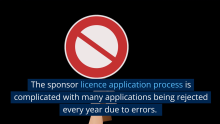Support migrant centric journalism today and donate

In an effort to improve customer support and save millions ofdollars, the United States Citizenship and Immigration Services (USCIS)began on Aug. 4 authorizing examiners to issue Employment AuthorizationDocuments (EADs) for periods of more than one year.
EADs areused for a variety of purposes, but one of the major uses is to provideinterim work authorization for people waiting on permanent residencyadjustment of status applications, which can take several years tocomplete. It is not unusual for applicants to have to renew the oneyear document several times.
Beginning Aug. 4, the USCISbegan issuing EADs for periods longer (and sometimes shorter) than oneyear. Four major criteria will determine how long USCIS will issue anEAD card, and they are:
- The applicant's immigration status
- The general processing time for the underlying application or petition
- Required background checks and processing times for background checks by other agencies
- Other security concerns
Thereare no set validity periods listed in the new rule except as itpertains to asylum seekers. Asylum seekers will be receiving five yearemployment authorization documents. This will help address a problemthat many have had proving their ability to work. This will largelycover them until they are eligible for green cards.
The USCISwill issue field guidance to standardize how EAD validity lengths willbe determined. In some cases, such as EADs issued to students as partof Optional Practical Training, the validity times are limited bystatute.
The USCIS also noted that validity times could getshorter as the Bureau of Citizenship and Immigration Services (BCIS)approaches its goal of six month maximum processing times on all cases.





















